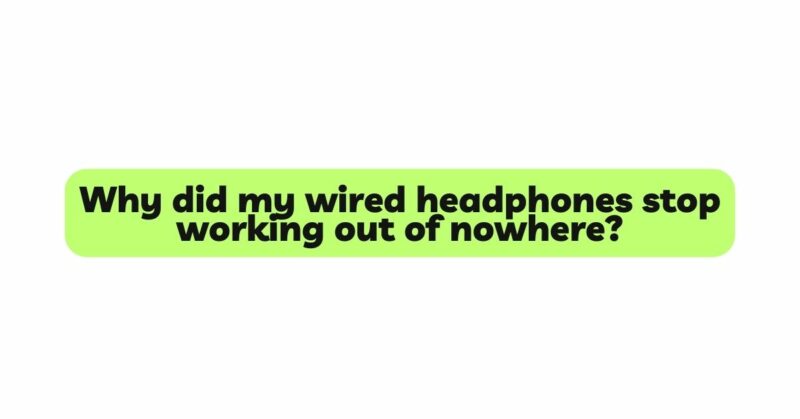The sudden failure of wired headphones can be a perplexing and frustrating experience for audio enthusiasts. One moment, you’re immersed in your favorite music or podcast, and the next, silence. “Why did my wired headphones stop working out of nowhere?” is a common question asked by users who find themselves facing this unexpected issue. In this comprehensive article, we will explore the various reasons behind the sudden failure of wired headphones, examining both internal and external factors that can contribute to this perplexing problem. By understanding the potential causes, users can troubleshoot and take preventive measures to prolong their headphones’ lifespan and maintain a satisfying audio experience.
- Cable Damage and Fraying:
One of the most common reasons for wired headphones to stop working out of nowhere is cable damage and fraying. Over time, headphone cables endure frequent bending, twisting, and pulling during regular use, which can lead to internal wire damage or insulation wear. If the damage reaches a critical point, the cable may break or lose connection, resulting in audio interruptions or a complete loss of sound.
- Connector Issues:
The connectors at the ends of the headphone cables are prone to damage from frequent plugging and unplugging. If the connectors become worn or loose, they may fail to establish a stable connection with the audio source, causing intermittent audio or no sound at all.
- Internal Driver and Speaker Damage:
The internal drivers or speakers of wired headphones are essential components responsible for audio output. They are sensitive to moisture, physical impacts, and temperature extremes. Accidental drops, exposure to water or excessive moisture, or rough handling can lead to compromised audio quality or complete audio loss in one or both sides.
- Wear on Earpads and Ear Tips:
Earpads and ear tips in wired headphones can deteriorate over time due to prolonged use. Worn-out earpads can lead to sound leakage and reduced audio quality, while deteriorating ear tips may affect sound isolation and comfort.
- External Physical Damage:
Wired headphones are susceptible to external physical damage, such as drops, impacts, or getting caught on objects accidentally. These incidents can cause structural issues or dislodge internal components, resulting in audio disruptions.
- Moisture and Water Exposure:
Moisture, particularly sweat during workouts or exposure to rain, can pose a significant threat to wired headphones. Water or moisture can corrode connections, damage internal circuits, and lead to sudden malfunctions.
- Environmental Factors:
Using wired headphones in extreme environmental conditions, such as high humidity, extreme temperatures, or dusty environments, can accelerate wear and tear, potentially leading to sudden headphone failure.
- Inadequate Audio Source or Device:
At times, headphone issues may not be with the headphones themselves, but rather with the audio source or device they are connected to. Malfunctioning audio jacks, incompatible audio settings, or software-related problems can cause sudden headphone disruptions.
- Wear and Tear over Time:
Like any electronic device, wired headphones experience wear and tear with extended use. Components may degrade or weaken over time, leading to a sudden loss of functionality.
- Manufacturer Defects:
In rare cases, wired headphones may suffer from manufacturing defects. These defects can range from issues with cable insulation and faulty wiring to incorrectly assembled internal components, resulting in sudden headphone failure.
Practical Solutions to Address Sudden Headphone Failure:
- Check the Cable and Connectors: Inspect the headphone cable and connectors for signs of damage or fraying. If you notice any issues, consider getting the cable replaced by a professional or using headphones with detachable cables.
- Proper Cable Management: Handle headphone cables with care, avoiding tight coiling, knots, or excessive bending. Utilize cable organizers to keep the cables organized and tangle-free when not in use.
- Clean and Maintain: Regularly clean the headphone earpads and ear tips to ensure optimal comfort and audio performance. Wipe down the headphone surfaces with a soft, slightly damp cloth to remove dirt and debris.
- Protect from Moisture: Choose sweat-resistant or waterproof headphones if you plan to use them during workouts or in humid environments. Avoid exposing wired headphones to water or excessive moisture.
- Store Headphones Safely: When not in use, store wired headphones in a dedicated case or pouch to protect them from dust, debris, and physical damage.
- Inspect the Audio Source: If the headphones are not working correctly, check the audio source or device they are connected to. Ensure that the audio jack is clean and free from debris and that the settings are configured correctly.
- Handle with Care: Treat wired headphones gently and avoid applying excessive force or impact.
- Address Manufacturing Defects: If the headphones are still under warranty, contact the manufacturer if you suspect a manufacturing defect. Professional repairs or a replacement may be possible if the defect is covered.
- Consider Detachable Cables: Invest in wired headphones with detachable cables. Detachable cables are easier to replace if they get damaged, potentially extending the headphone’s lifespan.
Conclusion:
The sudden failure of wired headphones can be attributed to various factors, including cable damage, connector issues, internal driver problems, environmental conditions, and moisture exposure. By understanding the common issues that can lead to headphone failure and implementing practical solutions to address and prevent these problems, users can prolong the lifespan of their audio devices and enjoy a satisfying audio experience. Proper care, maintenance, and handling of wired headphones are essential to ensure their reliable performance over time. By being attentive to potential causes of sudden headphone failure, users can troubleshoot and take proactive measures to prevent unexpected disruptions and continue enjoying their audio journeys uninterrupted.


